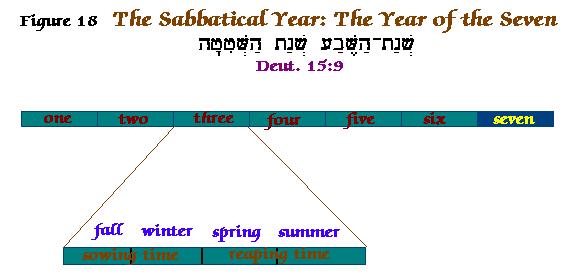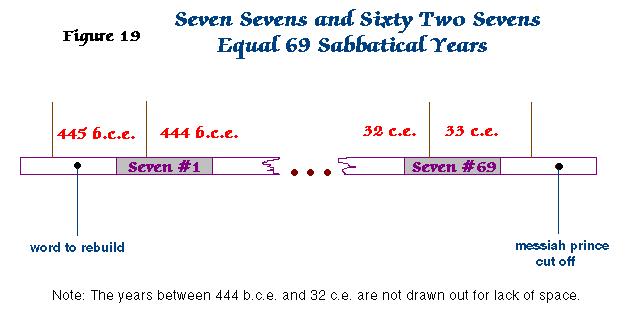|
|
|
|
§93
In the previous chapters it was shown that Christ died on the fourth day
of the week, that is, Wednesday, according to the planetary week.§125.1
It follows automatically that the Biblical date of his death was the lunar
14th of Aviv, the first month of the Biblical calendar. Only the
14th of Aviv can fall on the day before a Sabbath (The Passover Sabbath)
and be in the middle of the week (Wednesday). The 15th of Aviv is
the Passover Sabbath. If Christ died on the 15th, on a Wednesday,
then the 16th of Aviv would not be a Sabbath, hence that senario is disproven.§125.2
§94
According to the Law the 15th of Aviv is the Passover Sabbath (Lev. 23:11),
or rest day (see §612.1-616.3). Since the weekly Sabbath
cannot fall on the fifth day of the week, the only way Christ can die before
a Sabbath, is to die the day before the 15th of Aviv, i.e. the 14th of
Aviv (see Fig. 15).

§95
The red dot locates the time when Christ died and was buried.
The Biblical date of Christ's death is the 14th of Aviv, the first month
of the Biblical calendar.§118
§96
The Last Supper was eaten Tuesday night, (see Fig. 15). Matthew,
Mark, and Luke call the Last Supper, "the Passover," but by this they mean
only the first Seder held at the beginning of Passover week. Both
Seders were always celebrated in the dispersion, making the festival last
eight days, but at Jerusalem, the double Seder was optional. Both
meals, when eaten, were called, "the Passover." Not knowing this,
many scholars have mistakenly thought that Matthew, Mark, and Luke
meant the Seder with the sacrificed lamb on the evening of the 15th of
Aviv.
§97
Since the first Seder fell on Tuesday night that year, Yayshua and his
disciples would have been joined by all the Jews who used the Jubilees
calendar. According to the Jubilees calendar, there was one Seder,
always on Tuesday night, after sunset on Tuesday. The Samaritan Passover
was also at the same time, but we must not mistake Yayshua's observance
of the first Seder as an endorsement of that heresy.
§98
So, by "Passover," the first three gospels mean the first Seder, and not
the Seder with the sacrifice. There are other reasons why Yeshua
was killed before the second Seder; 1) Judas left the supper, and the disciples
assumed he might buy something, but buying and selling were not permitted
on the 15th of Aviv (John 13:29; Nehemiah 10:31; Lev. 23:6-7); this
demonstrates that the day of the Seder was not a Shabbaton (rest day)
for them, 2) The Jews complained to Pilate about the bodies on the tree
(John 19:31; Deut. 21:22-23). If it had already been the 15th of
Aviv, then the holy day would already be desecrated, and the complaint
would not have been made. For not only did they carry out the law
to take a man off a tree at nightfall, but they did not traditionally put
anyone to death on a tree on the holy days. 3) Simon of Cyrene came
in from the field to carry Yayshua's patibulum, but field work was not
done on the 15th of Aviv (Luke 23:26; Lev. 23:6-7). These reasons
weigh heavily against any 15th of Aviv theory. And the evidence we
presented in chapter one disproves it completely.
.
§99
Since we know the lunar date of Yayshua's death (the 14th of Aviv), and
the day of the week also (Wednesday), it is a straightforward matter to
locate astronomically those years in which the 14th day of the first moon
matches up with the fourth day of the week.
The
odds, given a random year, that such a synchronism will occur with a given
date and a given weekday are one in seven. Therefore if the number
of years is very great, more than one synchronism will be found.
Fortunately, biblical historians have already narrowed the date down: Harold
Hoehner gives the absolute limits as 26 c.e. to 36 c.e.§125
Actually, taking Roman history alone at face value allows us to limit the
range to 32 c.e. to 36 c.e. (a period of five years - see §300-306).
Astronomically,
the 14th of Aviv fell on the indicated days in these years (see Fig. 16).
For the treatment of the biblical calendar itself see §126-144.
.
26 3/9
Sabbath 22.8>4.5
27 3/28
Thursday 9.6>8.8
28 3/17
Tuesday 16.7>6.5
29 4/4
Monday 19.4>6.8
30 3/24
Friday 19.3>7.1
31 3/14
Tuesday 18.9>6.0
32 3/31
Monday 21.9>6.0
33 3/21
Friday 15.7>7.4
34 3/11
Wednesday 20.2 > 7.2
35 3/30
Tuesday 19.8>6.0
36 3/18
Sabbath 11.7>8.7

§102 The Angel Gabriel gave this remarkable prophecy to Daniel:
"Know therefore and understand that from the going forth of the word to restore and to build Jerusalem unto Messiah Prince shall be sevens seven, and sevens sixty two: she shall return, and be built wide and diligently, even in trouble of the times. And after the sevens sixty two Messiah shall be cut off, but not for himself" (Dan. 9:25-26a, my translation).§103 The key to this propehcy is to know what a "seven" is. A "seven" is not a "week" as the KJV translates, and most scholars recognize that the KJV translation is misleading. Keil and Delitzsch state, "the Sabbath-years, might be called sevens"§119 (pg. 339, vol. 9, Commentary on the Old Testament). Sabbath years are numbered with the numeral "seven" at the end of a sabbatic period, which explains how they can be called "sevens":


§116
In this chapter, we have subjected the Sabbath resurrection to two confirmations.
First, we found that a year does exist within the acceptable range of years
that meets the criteria for the 14th of Aviv to fall on the 4th day of
the week. Furthermore, we found that no other year meets that same
criteria so clearly. Then the Sabbath resurrection year, as determined
by astronomy, was subjected to confirmation by Daniel's prophecy.
It was found that it fit the parameters laid down by the prophecy perfectly.
§117
We may also state that the traditional years of 30, 31, and 33 c.e. all
fail to meet the criteria laid down by Daniel's prophecy, having at the
most 68 1/2 Sabbatic years in the interval, or failing to put the death
of messiah prince "after" the last sabbatic period.
.
§118
The Babylonian Talmud states, "On the eve of the Passover, Yeshu (ms. M:
the Nazarean) was hanged" (Sanhedrin 43a). Note that the spelling
"Yeshu" is an insult, and should not be used except to point out that it
is an insult.
§119
K. & D. "might" is too tenative: a sabbatical year is called
a "seven" (cf. Deut. 15:9: Year of the seven,[Sh'nat Ha-Shevah]).
It is permissible to translate the words, "seventy sevenths" (cf. BDB)
after the model of echad (one, first). Also note that
the Hebrew word for seven in Dan. 9:27 is different than the preceeding
usages. In that verse it means period of seven, not seventh(s), [i.e
shavuah, not shevah or sheva'im].
§120
Many Evangelicals and Fundamentalists compute from 444 B.C. using a 360
day year, i.e. 360*69*7 = 173880 days, and they find 173880 days
until April 3rd, 33 C.E. However, there is no evidence that a 360
day year was used in the scripture. Robert Anderson, who wrote The
Coming Prince, obtains a 360 day year on the basis of the year of Noah's
flood. Noah entered the ark on 2/17/600, the water prevailed 150
days till 7/17/600 when it landed on Ararat. Hence 150 days divided
by 5 months equals 30 days per month. Assuming 12 months per year
(a bad assumption) multiply 12 * 30 to get 360. Anderson's
computation, however, is invalid. It is possible to have 4 lunar
months of 30 days in a row followed by a 29 day month (see 6/8/2005 - 9/6/2005
in my Astronomical Almanac of Biblical Feasts), i.e. 30, 30, 30, 30, 29.
This makes up 149 days. The extra day to make 150 comes from including
7/17/600 in the count (see §620.9-625).
§121
The data from Noah's flood year thus agree with the lunar calendar, and
there is no need to resort to a solar calendar to explain it. The
360 day year was used by other pagan nations. Since this is the case,
Daniel's prophecy should be computed in terms of the calendar God instituted.
The necessary Astronomical synchronism for the year of the flood is obtained
in the year 2480 b.c.e.
§122
Other groups begin the calculation in 457 B.C.E., and end it in 27 C.E.
However, Daniel's prophecy cannot begin in 457 B.C.E. for several reasons.
The chief reason is that Ezra was given no decree to build either the temple
or any part of the city, but only money for sacrifices and some possible
interior decorating (Ezra 7:1-27). Besides, the temple was already
complete when Ezra arrived; the decree for this temple was given "in the
first year of Cyrus" (Ezra 6:3), and it was completed in the 6th year of
Darius (Ezra 6:15). On the other hand Ezra went up in the 7th year
of Artaxerxes (Ezra 7:1, 8), which is considered to be 457 by those who
hold this view.
§123
The "word" of the prophecy, however, requires the city to be rebuilt, something
only Nehemiah did.
§125
Hoehner, Harold W. Chronological Aspects of the Life of Christ.
Zondervan.
§125.1
The Planetary week is none other than our standard English week named after
the sun, moon, and five planets: sun, moon, mars, mercury, jupiter, venus,
saturn. The rest of the planets were not visible to the ancients.
§125.2
Many hold that Christ died on the 15th of Aviv, because they think he ate
the Passover on the 15th (e.g. Alfred Edersheim). This would be upon
the holy day itself. The Passover of the Pharisees, which was yet
to come, they explain as the festive sacrifice, and not the lamb.
The Sabbath Resurrection shows that this view is impossible. As for
the Passover issue, there is another explanation (see
§544-549).
§125.3
The search for 14th/Wednesday synchronisms can only be expanded by introducing
human errors into the computation of the calendar, either by failure to
observe a visible new moon due to unfavorable atmospheric conditions, in
which case the real month was a day later, or by failure to observe the
equinox, thereby placing the first month too late or too early. This
allowance greatly increases the chance of finding a synchronism in a given
year. Miscomputing the equinox increases it to three in seven, and
postponing the first day of the month also increases the odds to 4½
in 7. Projecting the Modern Hebrew Calendar back before its inception
(359 c.e.) yields yet more erroneous dates (see §142).
So finding other synchronisms depends on how much askew of the norm one
wants to go. Fortunately, there are other historical data that cinch
our case. Astronomy, merely makes it very probable. I have
given dates which assume no atmospheric problems, and assume that the first
month is in correct relation to the spring equinox.
.
Wed March 12, 27 c.e. too early Adar II
Wed April 28, 28 c.e. too late Ziv
Wed May 18, 29 c.e. too late Ziv (post
1)
Wed March 8, 30 c.e. too early Adar
Wed April 25, 31 c.e. too late
Ziv
Wed May 14, 32 c.e. too late
Ziv (post 1)
Wed May 11, 35 c.e. too late
Ziv
legacy name: www.parsimony.org